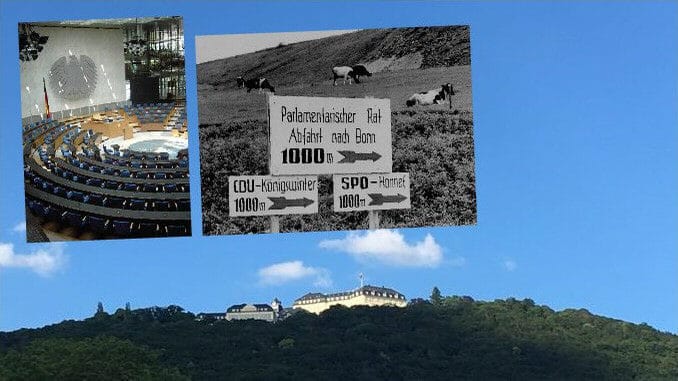
Now we have come to the last chapter in the history of our region, it covers the period from the Great War to the “Bonn years” of the Federal Republic of Germany.
Now historical events do not stick to dates, and therefore historical essays often speak of the “short 20th century”. This is obvious because the world before the outbreak of the Great War in 1914 and the epochal year 1917 was a different one.
The Great War
The Great War led to total mobilization all around the world, some 17 million people lost their lives. The Austro-Hungarian, German, Ottoman, and Russian Empires ceased to exist, with numerous new states created from their remains.
German Revolution of 1918/19
The war had ended, but the country was not in peace. Millions of soldiers had perished in battle. In Russia, the Bolsheviks had seized power and finally killed the Tsar and his family. The multi-ethnic Austria-Hungary was falling apart. In Germany, the mood swung against the Kaiser.
Occupation of the Rhineland
As the war propaganda had promised victory until the last moment, the defeat took people completely by surprise. Then, the situation suddenly changed. Several dozen American, Belgian, British and French divisions occupied the left bank of the Rhine and “bridgeheads” on the right bank. A 50-km-wide strip on the right bank of the Rhine was now a demilitarized zone. The war was over, but neither the Rhinelanders nor the occupying soldiers who had come from afar were yet at peace.
Weimar Republic
After the defeat in the World War I, Germany was in disastrous shape. Friedrich Ebert (SPD) had taken over government, but he could not win the old elites for the new, democratic regime.
Years of Crisis
The first German republic had to struggle from its start. While the members of the National Assembly in Weimar discussed a constitution, the victors of the Great War laid down hard peace terms in Versailles. The young republic faced numerous problems: Ruhr occupation and passive resistance, hyperinflation, separatists in the Rhineland, political extremism and putsches from the extreme left and right. Resentment in Germany towards the Treaty of Versailles was strong especially on the political right where there was great anger towards those who had signed and submitted to the treaty. Two republicans, Erzberger and Rathenau, were murdered.
Golden Era
Thanks to the Dawes Plan and the Young Plan, Germany got somewhat back on her feet economically. The Weimar Republic was granted a short time of economic recovery and political stability. These were the “Golden Twenties”. But the German democracy was shaky. Already in the middle of the twenties, the parties of the center and center-left lost many votes whereas the hardliners, even extremists on both sides grew stronger.
Depression and Decline
Foreign loans had helped Germany to recover economically. But then the “Black Thursday” in New York changed everything. The stock market into widened into a global crisis, sent the USA into the Great Depressing. It caused high unemployment in industrial countries, bank failure and collapse of credit. In Germany, the depression led to economic collapse, mass unemployment and pauperization. The Weimar Republic faced another devastating crisis.
From 1930 onwards, Reichspräsident von Hindenburg used his emergency powers to back chancellors that he appointed: Brüning, von Papen and von Schleicher. But many people turned to extremist parties such as Adolf Hitler’s Nazi Party and the Communists. In 1932, the Nazis became the largest faction in the Reichstag.
Nazi Germany
In 1933, Hindenburg appointed Adolf Hitler chancellor with the Nazi Party being part of a coalition government. Vice Chancellor von Papen was sure that he could keep Hitler under control. But within the first months of 1933, the Nazis seized power in an outwardly legal way. The Reichstag Fire Decree and the Enabling Act brought about a state of emergency, wiping out constitutional governance and civil liberties.
The totalitarian dictatorship began, Germany quickly and thoroughly became Nazi Germany. Jews and minorities were disenfranchised, the secret state police Gestapo and concentration camp guards terrorized the people. In 1939, the Second World War broke out.
World War II
The Second World War was even more devastating than the first. It raged between 1939 and 1945 and affected the civilians more than any war before. Over seventy million people were killed. Hitler had wanted this war from the very beginning. Not only to re-establish the German Reich of 1914 and do something against the peace Treaty of Versailles with was perceived as shameful – it was a war of conquest and annihilation in the east. After World War II, Germany had to start all over again.
Federal Republic
The last chapter deals with the democratic new beginning after the Second World War, the “Bonn Republic” and the state guests on the Petersberg.
At the end of the 20th century, in 1989, there is again a tremendous upheaval. Yes, the actual 20th century was short.
A look beyond the Rhineland
Irish War of Independence (1919-1921), President Franklin D. Roosevelt’s New Deal recovery program, Vietnam War (1961-1973), Luther King and Robert Kennedy assassinated (1968).
20th century
The short 20th century | The Great War | German Revolution 1918/19 | Occupation of the Rhineland | Weimar Republic | Nazi Germany | World War II | Federal Republic of Germany
References
Both photos are from the German Wikipedia.
Verkehrsschild für die Anfahrt zum Parlamentarischen Rat bei Bonn 1949, Creative Commons Attribution Share Alike 3.0 Unported, 2.5 Generic, 2.0 Generic and 1.0 Generic, author: Bundesstadt Blues.
Neuer Plenarsaal des Bundestags in Bonn, Creative Commons Attribution Share Alike 3.0 Unported, author: Qualle

Be the first to comment